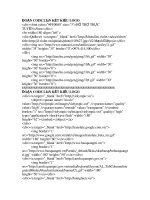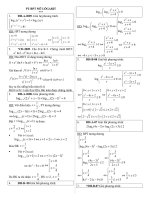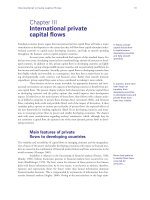PETROLEUM DEVELOPMENT GEOLOGY LOG INTERPRET
Bạn đang xem bản rút gọn của tài liệu. Xem và tải ngay bản đầy đủ của tài liệu tại đây (3.11 MB, 68 trang )
1. WHAT IS WELL LOGGING:
1. WELL LOG IS A CONTINUOUS RECORD OF MEASUREMENT MADE IN
BORE HOLE RESPOND TO VARIATION IN SOME PHYSICAL
PROPERTIES OF ROCKS THROUGH WHICH THE BORE HOLE IS
DRILLED.
2. TRADITIONALLY LOGS ARE DISPLAY ON GIRDED PAPERS SHOWN IN
FIGURE.
3. NOW A DAYS THE LOG MAY BE TAKEN AS FILMS, IMAGES, AND IN
DIGITAL FORMAT.
2. WIRELINE LOGGING IS PERFORMED WITH A SONDE LOWERED INTO THE
BOREHOLE OR WELL
3. 2 TYPES OF WIRELINE LOGGING :
1. OPEN HOLE LOGGING
2. CASED HOLE LOGGING
4. INTERPRETATION METHODS
1. QUALITATIVE
2. QUANTITATIVE
1. MANUAL
2. COMPUTERIZED
LITHOLOGY
TOP SAND
SAND THICKNESS
SAND PROSITY
PERMEABILITY
FLUID SATURATIONS
IS A PROCESS OF USING WELL LOGS TO
EVALUATE THE CHARACTERISTIC OF
FORMATION :
•
STORAGE CAPACITY å porosity,
•
GEOLOGICAL SETTING å
fluid saturations and net pay
thickness
• FLUID PROPERTIES å density, fluid
type, fluid contacts, API gravity,
water resistivity & salinity,
temperature, GOR
structural/dip/fracture, geologic
environtment, facies characteristic,
top/bottom reservoir,
heterogeneities, distribution
• PRODUCTIVITY : permeability, water
cut, GOR and rate (estimated)
LOG INTERPRETATION
Log interpretation should provide answers to questions on:
IS PART OF RESERVOIR CHARACTERIZATION PROCESS WHICH
SHOULD BE INTEGRATED WITH THE FOLLOWING SURVEY
AND ANALYSIS:
– DRILLING OPERATION LOGS:
• CUTTING ANALYSIS, MUD ANALYSIS, DRILLING DATA COLLECTION
(PRESSURE, GAS READING, PENETRATION RATE ETC.) AND
ANALYSIS.
– CORRING & CORE ANALYSIS :
• SIDE WALL CORE & FULL HOLE CORE
• VISUAL LITHOLOGY DESCRIPTION, HYDROCARBON SHOWS,
POROSITY, PERMEABILITY, FORMATION FACTOR, SATURATION
ETC.
– PRODUCTIVITY TEST :
• RFT, MDT, DST, PRODUCTION TESTS
– GEOLOGY & GEOPHYSICAL :
• SURFACE GEOLOGY, SEISMIC SURVEY & INTERPRETATION ETC.
LOGGING UNIT CONTAINS:
• logging cable
• winch to raise and lower
the cable in the well
• self-contained 120-volt
AC generator
• set of surface control
panels
• set of downhole tools
(sondes and cartridges)
• digital recording system
Open Hole Logging :
1. The traditional wireline
logging
2. Logging While Drilling
3. Logging on drill pipe
Logging Job Sequences :
î
Rig-up logging unit
î
î
î
LOGGING UNIT
î
Tool run in hole
î
WIRELINE
î
The system is on but never be
used for log interpretation
Pull-out and logging
î
î
SONDE / TOOL
î
Check Tool and system
Wellsite Geologist (WG) will
perform system & tool quality
control
Safety meeting
WG is the witness, checks the
logging speed and quality.
WG has authority to stop, refuse
and re-logging when necessary
Rig-down the logging unit.
î
î
Print the result
WG signs the services ticket
containing type of services and
charges
SAMPLE :
OPEN HOLE LOG
SP, GR, AIT, SONIC,
DENSITY & NEUTRON
RHOZ
AIT
NPHI
SP
GR
DT
1. SP å SPONTANEOUS
POTENTIAL LOG
2. GR å GAMMA RAY LOG
3. ELECTRICAL LOG å
INDUCTION, LATERAL,
SPHERICAL FOCCUSS, MICRO
LATERAL ETC
4. NEUTRON LOG å CNL, SNP
5. DENSITY LOG å LDT
6. SONIC LOG å BHC
7. OTHERS : FMI (DIPMETER &
IMAGING), NMRI (Nuclear
Magnetic Resonance Immaging,
TEMPERATURE LOG, CALLIPER
LOG, ETC.
¬ SP results from electric
currents flowing in the
drilling mud.
¬ There are three sources of
the currents, two
electrochemical and one
electrokinetic.
Ü Membrane potential largest.
Ü Liquid - junction potential.
Ü Streaming potential smallest.
• The SSP is the
quantity to be
determined.
• It is the deflection
seen on the SP from
the Shale Base Line
(zero point) to the
Sand Line (max.
deflection)
•
Differentiate potentially porous and
permeable reservoir rocks from
impermeable clays.
•
Define bed boundaries, top &
bottom of the layer.
•
For geological correlation
•
Give an indication of shaliness
(maximum deflection is clean;
minimum is shale).
•
Indicate vertical grain size
distribution
•
Determine Rw (formation water
resistivity) in both salt and fresh
muds.
R mfe
SSP
= − k log
R
we
SHALE BASE LINE
SP scale
+
•
Baseline shifts: These can occur when there are beds
of different salinities separated by a shale which does
not act as a perfect membrane.
•
•
•
The SP can be affected by a number of surface effects as it relies on
the fish as its reference electrode.
Power lines, electric trains, electric welding, close radio
transmitters:
All these create ground currents which disrupt he "fish“ reference
causing a poor, sometimes useless, log.
• The Gamma Ray log is a
measurement of the formation's
natural radioactivity.
• Gamma ray emission is produced by
three radioactive series found in the
Earth's crust.
– Potassium (K40) series.
– Uranium series.
– Thorium series.
• Gamma rays passing through rocks
are slowed and absorbed at a rate
which depends on the formation
density.
• Less dense formations exhibit more
radioactivity than dense formations
even though there may be the same
quantities of radioactive material per
unit volume.
• Bed definition å top,
bottom, thickness
• Shalliness å content
and net thickness, The
minimum value gives
the clean (100%) shale
free zone, the maximum
100% shale zone.
NEUTRON TOOLS
•
The first neutron tools used a chemical neutron source and
employed a single detector which measured the Gamma Rays
of capture. They were non-directional. The units of
measurement were API units where 1000 API units were
calibrated to read 19% in a water-filled limestone. The tool was
badly affected by the borehole environment.
•
The second generation tool was the Sidewall Neutron Porosity
(SNP). This was an epithermal device mounted on a pad.
•
The current tool is the Compensated Neutron Tool (CNT). The
latest tool is the Accelerator Porosity Sonde (APS), using an
electronic source for the neutrons and measuring in the
epithermal region.
NEUTRON
USES
• POROSITY &
LITHOLOGY å
with density log
• HYROCARBON
INDICATION å
The tool measures
hydrogen index
• The Density Tools use a chemical gamma ray source
and two or three gamma ray detectors.
• The number of gamma rays returning to the detector
depends on the number of electrons present, the
electron density, ρe.
• The electron density can be related
to the bulk density of the minerals
by a simple equation.
•
ρe = ρ( 2Z/A )
Where Z is the number of
electrons per atom and A is
the atomic weight.
•
The density tool is extremely
useful as it has high accuracy
and exhibits small borehole
effects.
• Major uses include:
– Porosity.
– Lithology (in combination
with the neutron tool).
• Mechanical properties (in
combination with the sonic
tool).
• Acoustic properties (in
combination with the sonic
tool).
• Gas identification (in
combination with the neutron
tool).
ρ
b
=
ρ
φ
f
=
φ + ρ
ρ
ρ
ma
ma
ma
(1
− ρ
− ρ
− φ
)
b
f
• There are two inputs into the porosity equation: the matrix
density and the fluid density.
• The fluid density is that of the mud filtrate.
Ü The sonic tools create an
Ü
Ü
acoustic signal and measure
how long it takes to pass
through a rock.
By simply measuring this time
we get an indication of the
formation properties.
The amplitude of the signal
will also give information
about the formation.
•
•
•
•
A simple tool that uses a pair of transmitters and four receivers
to compensate for caves and sonde tilt.
The normal spacing between the transmitters and receivers is
3' - 5'.
It produces a compressional slowness by measuring the first
arrival transit times.
Used for:
–
–
–
–
Correlation.
Porosity.
Lithology.
Seismic tie in /
time-to-depth
conversion.









